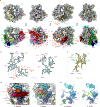Evolutionary compaction and adaptation visualized by the structure of the dormant microsporidian ribosome
- PMID: 31332387
- PMCID: PMC6814508
- DOI: 10.1038/s41564-019-0514-6
Evolutionary compaction and adaptation visualized by the structure of the dormant microsporidian ribosome
Abstract
Microsporidia are eukaryotic parasites that infect essentially all animal species, including many of agricultural importance1-3, and are significant opportunistic parasites of humans4. They are characterized by having a specialized infection apparatus, an obligate intracellular lifestyle5, rudimentary mitochondria and the smallest known eukaryotic genomes5-7. Extreme genome compaction led to minimal gene sizes affecting even conserved ancient complexes such as the ribosome8-10. In the present study, the cryo-electron microscopy structure of the ribosome from the microsporidium Vairimorpha necatrix is presented, which illustrates how genome compaction has resulted in the smallest known eukaryotic cytoplasmic ribosome. Selection pressure led to the loss of two ribosomal proteins and removal of essentially all eukaryote-specific ribosomal RNA (rRNA) expansion segments, reducing the rRNA to a functionally conserved core. The structure highlights how one microsporidia-specific and several repurposed existing ribosomal proteins compensate for the extensive rRNA reduction. The microsporidian ribosome is kept in an inactive state by two previously uncharacterized dormancy factors that specifically target the functionally important E-site, P-site and polypeptide exit tunnel. The present study illustrates the distinct effects of evolutionary pressure on RNA and protein-coding genes, provides a mechanism for ribosome inhibition and can serve as a structural basis for the development of inhibitors against microsporidian parasites.
Conflict of interest statement
Competing interests
The authors declare no competing interests.
Figures




References
-
- Franzen C Microsporidia: a review of 150 years of research. Open Parasitol. J 2, 1–34 (2008).
-
- Higes M et al. How natural infection by Nosema ceranae causes honeybee colony collapse. Environ. Microbiol 10, 2659–2669 (2008). - PubMed
-
- Corradi N Microsporidia: eukaryotic intracellular parasites shaped by gene loss and horizontal gene transfers. Annu. Rev. Microbiol 69, 167–183 (2015). - PubMed
Publication types
MeSH terms
Substances
Grants and funding
LinkOut - more resources
Full Text Sources
Other Literature Sources

